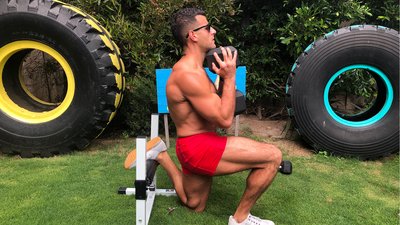I had four knee surgeries by the time I was 22 due to football injuries and—I'll own it—from training like an idiot when I was younger. All I used to care about was going heavy or going home, no matter the cost to my body. But when my surgeon told me I had the cartilage damage of an 80-year-old following my final operation, I knew I had to find a new approach to training my legs while sparing my joints. Anyone nodding along yet?
I'm now 36 and my legs have never been bigger and most importantly, my knees have never felt better. I credit a great deal of this to adopting a smarter, more risk-averse exercise selection for leg day. And if I had to pick just one lower-body builder to construct that day around, it would be the Bulgarian split squat (BSS) or rear-foot-elevated split squat.
I'm not alone, either. This is a move that both bodybuilders and high-performance athletes and coaches swear by. And if you ride it hard for all it's worth for a few weeks like I lay out here, it can pay off big time. Here's everything you need to know.
From Bulgaria with Love
A number of studies over the last decade have compared the BSS to the barbell back squat, and over and over again, have found similar strength and muscle gains, as well as overall muscle activation, ground force production, and even testosterone production using the BSS.[1-3] The difference? They needed far less weight—and far less loading on the spine and knees—to get those effects.
Plenty of people simply never feel comfortable doing heavy back squats, either. This shouldn't be discounted! There's no law dictating that one squat "counts" and another doesn't. At 6-foot-2, 225 pounds, with long femurs, back squats have just never felt right for my body. But I found the perfect muscle-building marriage with Bulgarians, which have unique benefits compared to traditional squatting:
- Lighter loads go further
- Less spinal loading
- Improves strength imbalances between sides
- Improves hip mobility
- Easier to recover from
- Unreal muscle pumps
The only downside? They're humbling, painful during the set, and can make you sore like nothing else. But it's the good kind of sore. Don't worry, you'll heal up.
How to Find Your Perfect Stance
Before I share what will be one of the most epic leg days of your life, let me first make two quick technique points.
First, you can perform this exercise with either a long or close stance. A longer stance, with a more vertical shin angle, works your glutes harder. A closer stance, where your knee travels more (without the heel leaving the ground) works your quads harder.
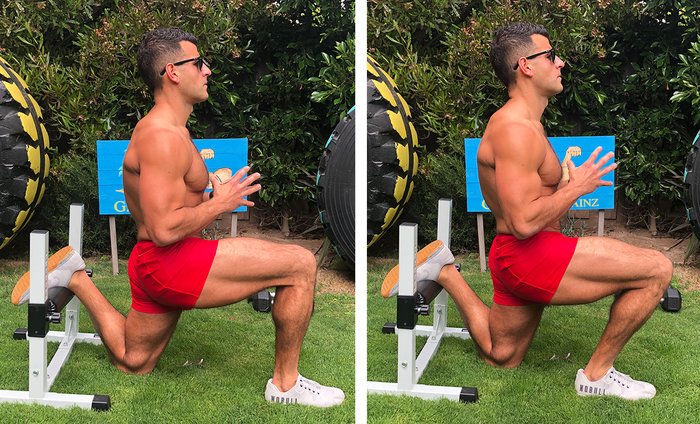
Both options have their place. I personally prefer a closer stance because I find it promotes better spinal position—many people tend to hyperextend their lower backs with the long stance. However, sometimes a closer stance can bother people with a history of knee pain.
Regardless of which option you choose, rest assured your quads and glutes will both get a great training effect. Listen to your body and pick whatever variation works best for you.
And second, you can hold the weights in two positions: hip or shoulder level.
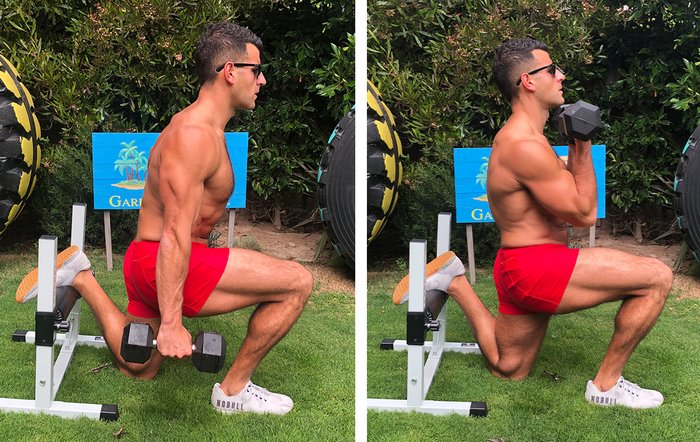
Hip level will encourage more of a forward trunk angle and hip-hinge that will shift the stress a bit more to the glutes and hamstrings. It will also allow for the heaviest loads. Grip tends to be the limiting factor with this variation.
Shoulder level creates a more vertical trunk positioning that crushes the quads more. It will also make lighter loads go further. For example, 25s at shoulder level tend to feel as challenging as 50s at hip level. It also works your core more. If a pair of dumbbells feels awkward, a single heavy dumbbell held in the goblet position will give all the same benefits.
Holding the weights overhead is the most challenging option, but most people don't have the shoulder mobility and core stability to pull this off. Plus, balance can quickly become a serious challenge. Given that the BSS has so much appeal as a safe alternative to back squatting, why add any riskiness to it?
The 5-10-MAX Protocol
This is one of my all-time favorite metabolic bodybuilding protocols. It will completely exhaust all of your muscle fibers and develop strength, power, and endurance. It also taps into the three key mechanisms of muscle growth: mechanical tension, muscle damage, and metabolic stress.
All you need is a pair of dumbbells, or one heavy dumbbell held in the goblet position at shoulder level, and a single-leg squat stand. Don't have a stand? Use a box, bench, chair, couch, or ottoman to elevate your trail leg.
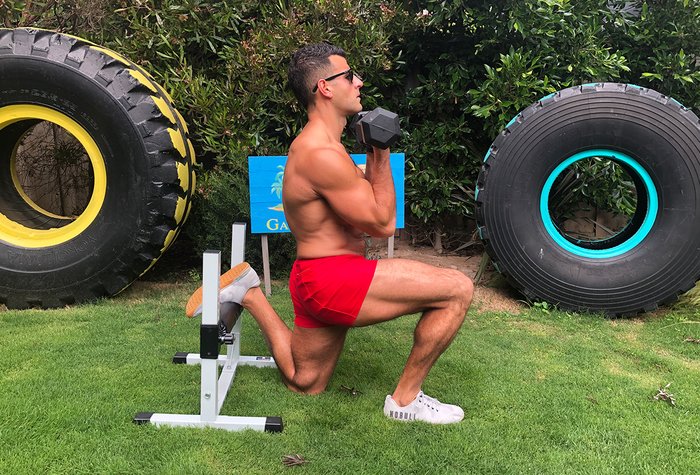
The weight you start with is up to you, but for somewhat experienced lifters, I recommend starting with a pair of 25-50 pounders and slowly building your way up from there. The ultimate showcase of strength? Being able to handle 100 pounds in each hand.
But you're not there yet. So start with weights you can handle, and do this protocol:
The One-Move Leg Workout from Hell
- Dumbbell Bulgarian split squat, 5 reps.(Use the heaviest weight you can handle for 5 picture-perfect reps. Then rest 15-30 sec.)
- Jumping Bulgarian split squat, 10 reps.(These are body weight only, and the focus is on exploding off the ground with each rep in a plyometric style. If you can't quite do that, then just focus on doing fast, clean bodyweight reps.)
- Bodyweight Bulgarian split squat, max reps.(These are to build endurance and get that pump. Crank them out like a piston and don't lock them out all the way, keeping tension in the working leg.)
- Do all of that for just one leg, rest 1-2 minutes, and do it for the the other leg. All of that is one round.
How to program this workout:
- Option 1: Do a single round as a starter or finisher in any style of workout: legs, full-body, or whatever else works for you.
- Option 2: Do 3-5 total rounds for a full leg workout, resting 1-2 minutes between rounds. Start with just 2-3 rounds in the beginning to avoid excessive muscle soreness.
Why and How This Workout Works
The heavier work upfront fires up your fast-twitch muscle fibers and excites your nervous system. This in turn primes your body to produce more power with the unloaded plyometric reps to follow. And finishing with max reps is all about dialing in a mind-muscle connection and maxing out the pump and burn.
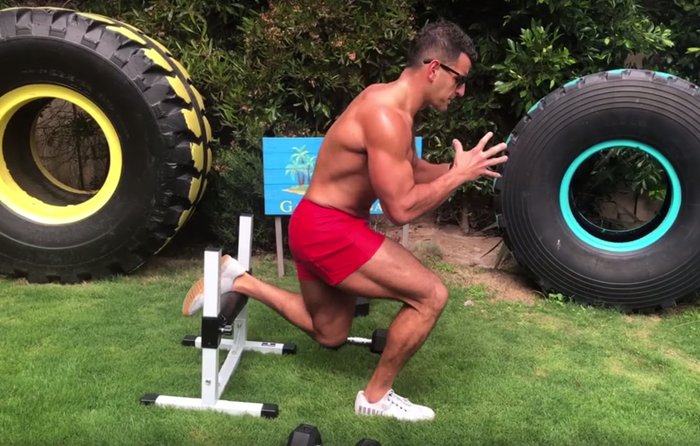
For best results, use a "constant tension" stimulus on all the reps, where you keep at least a quarter bend in the knee of the lead/work leg at the top of the movement. Visualize using your quads and glutes to lift and lower your body, while you hang on for dear life.
Once you can fairly easily do 5 reps with a given weight for each round of the weighted squats, bump the weight up 5-10 pounds the next session. But don't add weight to the two bodyweight moves that follow.
If you find yourself with a pair of dumbbells that isn't challenging enough or you want to create an even greater muscle-building stimulus, take 3-5 seconds to lower during the initial 5 heavy reps. Accentuating the eccentric or negative phase of a rep makes lighter loads go even further, and is guaranteed to create more muscle damage.
If it still isn't challenging enough, just do max reps with whatever dumbbells you have access to. You'll still build strength and get the heavy-to-light contrast needed to make this protocol work.
Do this routine once per week for 6-12 weeks and watch your legs grow like weeds. You'll also bulletproof your joints, feel great, and enhance performance in your other lifts or sport.
Let the gains begin, baby!
Want a workout plan that helps you further develop your strength, power, and endurance? True Muscle: 9 Weeks to Elite Fitness balances strength and muscle work with top-notch mobility and conditioning, giving you a well-rounded approach that you can use as a model for whatever comes next!
References
- DeForest, B. A., Cantrell, G. S., & Schilling, B. K. (2014). Muscle activity in single-vs. double-leg squats. International Journal of Exercise Science, 7(4), 302.
- Eliassen, W., Saeterbakken, A. H., & van den Tillaar, R. (2018). Comparison of bilateral and unilateral squat exercises on barbell kinematics and muscle activation. International Journal of Sports Physical Therapy, 13(5), 871.
- Jones, M. T., Ambegaonkar, J. P., Nindl, B. C., Smith, J. A., & Headley, S. A. (2012). Effects of unilateral and bilateral lower-body heavy resistance exercise on muscle activity and testosterone responses. The Journal of Strength & Conditioning Research, 26(4), 1094-1100.



